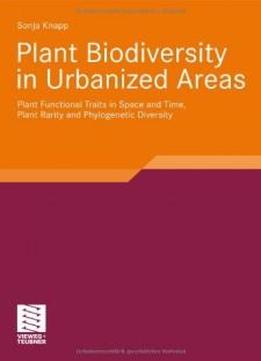
Plant Biodiversity In Urbanized Areas: Plant Functional Traits In Space And Time, Plant Rarity And Phylogenetic Diversity
by Sonja Knapp /
2009 / English / PDF
1.4 MB Download
Urbanization is one of the main drivers of global change. It often
takes place in areas with high biodiversity, threatening species
worldwide. To protect biodiversity not only outside but also right
within urban areas, knowledge about the effects of urban land use
on species assemblages is essential. Sonja Knapp compares several
aspects of plant biodiversity between urban and rural areas in
Germany. Using extensive databases and modern statistical methods,
she goes beyond species richness: Urban areas are rich in species
but plant species in urban areas are closer related to each other
than plant species in rural areas, respectively. The urban
environment, characterized by high temperatures and frequent
disturbances, changes the functional composition of the flora. It
promotes e.g. short-lived species with leaves adapted to drought
but threatens insect-pollinated or wind-dispersed species. The
author claims that the protection of biodiversity should not only
focus on species richness but also on functional and phylogenetic
diversity, also right within urban areas, to preserve a flora with
a high potential for adaptation to changing global conditions.
Urbanization is one of the main drivers of global change. It often
takes place in areas with high biodiversity, threatening species
worldwide. To protect biodiversity not only outside but also right
within urban areas, knowledge about the effects of urban land use
on species assemblages is essential. Sonja Knapp compares several
aspects of plant biodiversity between urban and rural areas in
Germany. Using extensive databases and modern statistical methods,
she goes beyond species richness: Urban areas are rich in species
but plant species in urban areas are closer related to each other
than plant species in rural areas, respectively. The urban
environment, characterized by high temperatures and frequent
disturbances, changes the functional composition of the flora. It
promotes e.g. short-lived species with leaves adapted to drought
but threatens insect-pollinated or wind-dispersed species. The
author claims that the protection of biodiversity should not only
focus on species richness but also on functional and phylogenetic
diversity, also right within urban areas, to preserve a flora with
a high potential for adaptation to changing global conditions.











